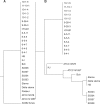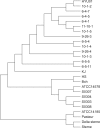Genetic diversity of Korean Bacillus anthracis isolates from soil evaluated with a single nucleotide repeat analysis
- PMID: 23820210
- PMCID: PMC3885740
- DOI: 10.4142/jvs.2013.14.4.457
Genetic diversity of Korean Bacillus anthracis isolates from soil evaluated with a single nucleotide repeat analysis
Abstract
Bacillus (B.) anthracis, the etiological agent of anthrax, is one of the most genetically monomorphic bacteria species in the world. Due to the very limited genetic diversity of this species, classification of isolates of this bacterium requires methods with high discriminatory power. Single nucleotide repeat (SNR) analysis is a type of variable-number tandem repeat assay that evaluates regions with very high mutation rates. To subtype a collection of 21 isolates that were obtained during a B. anthracis outbreak in Korea, we analyzed four SNR marker loci using nucleotide sequencing analysis. These isolates were obtained from soil samples and the Korean Center for Disease Control and Prevention. The SNR analysis was able to detect 13 subgenotypes, which allowed a detailed evaluation of the Korean isolates. Our study demonstrated that the SNR analysis was able to discriminate between strains with the same multiple-locus variable-number tandem repeat analysis genotypes. In summary, we obtained SNR results for four SNR marker loci of newly acquired strains from Korea. Our findings will be helpful for creating marker systems and help identify markers that could be used for future forensic studies.
Keywords: Bacillus anthracis; molecular diversity; single nucleotide repeats; subgenotyping.
Figures



Similar articles
-
Single-nucleotide repeat analysis for subtyping Bacillus anthracis isolates.J Clin Microbiol. 2006 Mar;44(3):777-82. doi: 10.1128/JCM.44.3.777-782.2006. J Clin Microbiol. 2006. PMID: 16517854 Free PMC article.
-
High resolution genotyping of Bacillus anthracis outbreak strains using four highly mutable single nucleotide repeat markers.Lett Appl Microbiol. 2008 May;46(5):600-3. doi: 10.1111/j.1472-765X.2008.02353.x. Epub 2008 Mar 18. Lett Appl Microbiol. 2008. PMID: 18363651
-
Molecular characterization of Korean Bacillus anthracis isolates by amplified fragment length polymorphism analysis and multilocus variable-number tandem repeat analysis.Appl Environ Microbiol. 2005 Aug;71(8):4664-71. doi: 10.1128/AEM.71.8.4664-4671.2005. Appl Environ Microbiol. 2005. PMID: 16085861 Free PMC article.
-
Single nucleotide repeat analysis of B. anthracis isolates in Canada through comparison of pyrosequencing and Sanger sequencing.Vet Microbiol. 2014 Mar 14;169(3-4):228-32. doi: 10.1016/j.vetmic.2013.12.020. Epub 2014 Jan 10. Vet Microbiol. 2014. PMID: 24485934
-
Bacillus anthracis evolution and epidemiology.Curr Top Microbiol Immunol. 2002;271:21-32. doi: 10.1007/978-3-662-05767-4_2. Curr Top Microbiol Immunol. 2002. PMID: 12224522 Review.
Cited by
-
Genetic source tracking of an anthrax outbreak in Shaanxi province, China.Infect Dis Poverty. 2017 Jan 17;6(1):14. doi: 10.1186/s40249-016-0218-6. Infect Dis Poverty. 2017. PMID: 28093076 Free PMC article.
References
-
- Glover DM. DNA cloning : a practical approach. vol. 1, 2 Oxford: IRL; 1985.
-
- Hill KK, Ticknor LO, Okinaka RT, Asay M, Blair H, Bliss KA, Laker M, Pardington PE, Richardson AP, Tonks M, Beecher DJ, Kemp JD, Kolstø AB, Wong ACL, Keim P, Jackson PJ. Fluorescent amplified fragment length polymorphism analysis of Bacillus anthracis, Bacillus cereus, and Bacillus thuringiensis isolates. Appl Environ Microbiol. 2004;70:1068–1080. - PMC - PubMed
Publication types
MeSH terms
LinkOut - more resources
Full Text Sources
Other Literature Sources

